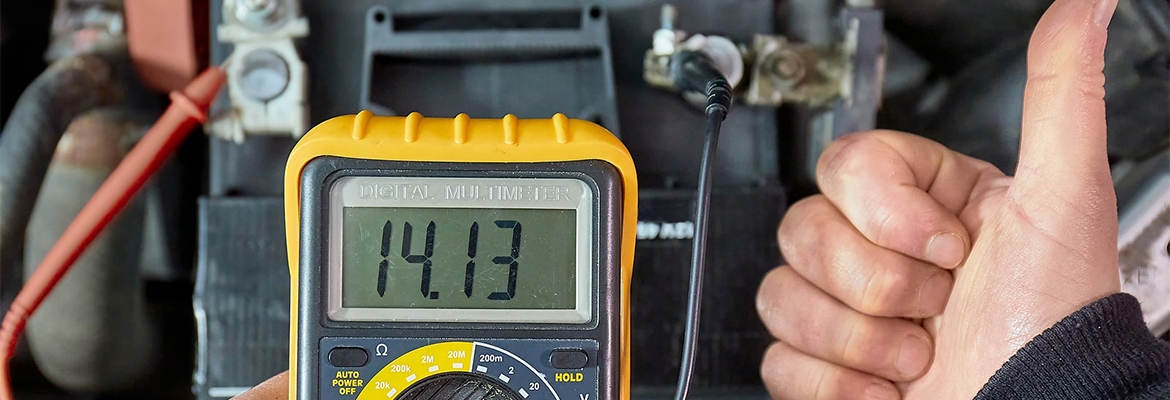Car Won't Start? Signs of a Bad Starter.
A car that won't start can leave you stranded. In many cases, this problem is caused by a bad starter.
The good news is there are signs of a bad starter. If you know what to look for, you may be able to address the issue with the help of a tire shop or auto repair facility before the starter gives out and leaves you without transportation.
Below, we've shared information that can help you identify and address starter problems.
What Is a Starter?
Your car starter is the part of the vehicle that gets the engine running. Essentially, it's a small electric motor that cranks the engine. By cranking the engine, the starter helps give the car the power it needs to move from a standstill.
The starting system in your car consists of the electric motor and an attached component called a solenoid. The solenoid shuttles power from your car's battery to the starter motor. The solenoid also moves the starter gear forward which allows the gear to connect with the teeth of the engine's flywheel.
Where Is the Starter Located in a Car?
The starter is found on the driver's side of the engine. It's typically placed just beneath the left bank of cylinders.
What Does a Starter Look Like in a Car?
The starter can be identified by its cylindrical shape. It looks like a large cylinder with a smaller cylinder attached.
How Long Does a Starter Last?
Your original starter can last throughout most or all of your vehicle's lifespan.
The starter motor is only used when you crank the engine. Since it's not as heavily used as some of a car's other parts, it can last a long time. It is difficult to predict when or if this part will fail. When the starter motor fails, wear and tear is often the cause.
What Are the Signs of a Bad Starter?
Here are some signs of a bad starter solenoid or a bad starter:
- Starter fails to engage
- The starter is sluggish when cranking the engine
- Engine fails to turn over
- Turning the key in the ignition makes a loud click, but the engine fails to turn over
- The starter makes excessive noise when cranking the engine
- Starter remains engaged when the vehicle is being driven, creating a grinding sound
- The engine doesn't start consistently
What Does a Bad Starter Sound Like?
There are specific sounds that let you know when a starter needs repair. Here are some sounds that indicate starter trouble:
- A whirring sound when you turn the key to crank the engine. This sounds like the whirring made by a vacuum cleaner or a household fan.
- A harsh grinding noise. This occurs when the teeth of the starter motor fail to mesh with the teeth on the engine's flywheel. If you hear this grinding sound, stop cranking the engine. Continuing to crank the engine could break the flywheel's teeth, which is costly to repair.
- A clicking sound. If you hear one or more clicks when trying to start the car, it indicates that the starter gear isn't connecting with the flywheel.
How to Test a Starter Solenoid with a Multimeter
If you're worried about the health of your starter, test it with a multimeter. A multimeter is a tool used to troubleshoot electrical components and devices. Here are the steps to follow:
- Attach the multimeter's positive wire (usually red) to the positive terminal on the solenoid.
- Then connect this device's negative wire (it's typically black) onto the terminal coming from the battery.
- Have someone start the engine while you observe the values shown on the multimeter. The voltage reading should drop when the engine starts. If the voltage change is significantly more or less than 0.5 volts -- or if the multimeter doesn't display a value at all -- it could indicate a defective solenoid.
How to Start a Car with a Bad Starter
Wondering how to start a car with a bad starter solenoid or bad starter? Here are a couple of emergency options you can use to get the vehicle up and running so you can take it to a repair shop:
- If your car has a manual transmission, turn the key to the "On" position. Push the car until it moves forward at a slow pace. Shift into second gear with your foot on the clutch, then engage the clutch. Once the engine is spinning fast enough to idle, take your foot off the clutch. The engine should be up and running at this point.
- Sometimes starter problems are caused by a bad connection. Lift the hood and locate the starter. Then tap the starter firmly with an object such as a tire iron. If a connection issue caused the starter problem, tapping it in this way may be enough to re-establish the connection and get the starter working again.
How to Fix a Car Starter
You may be able to fix a car starter by tapping it, as explained above. This will work if the starter problem is caused by a connection issue.
However, if a defective starter caused the problem, it will need to be replaced. The easiest way to handle this task is to turn it over to a skilled service technician.
Final Thoughts
To avoid the inconvenience caused by a failed starter, pay attention to this component. Watch for the signs that indicate starter problems and quickly address the issue.


